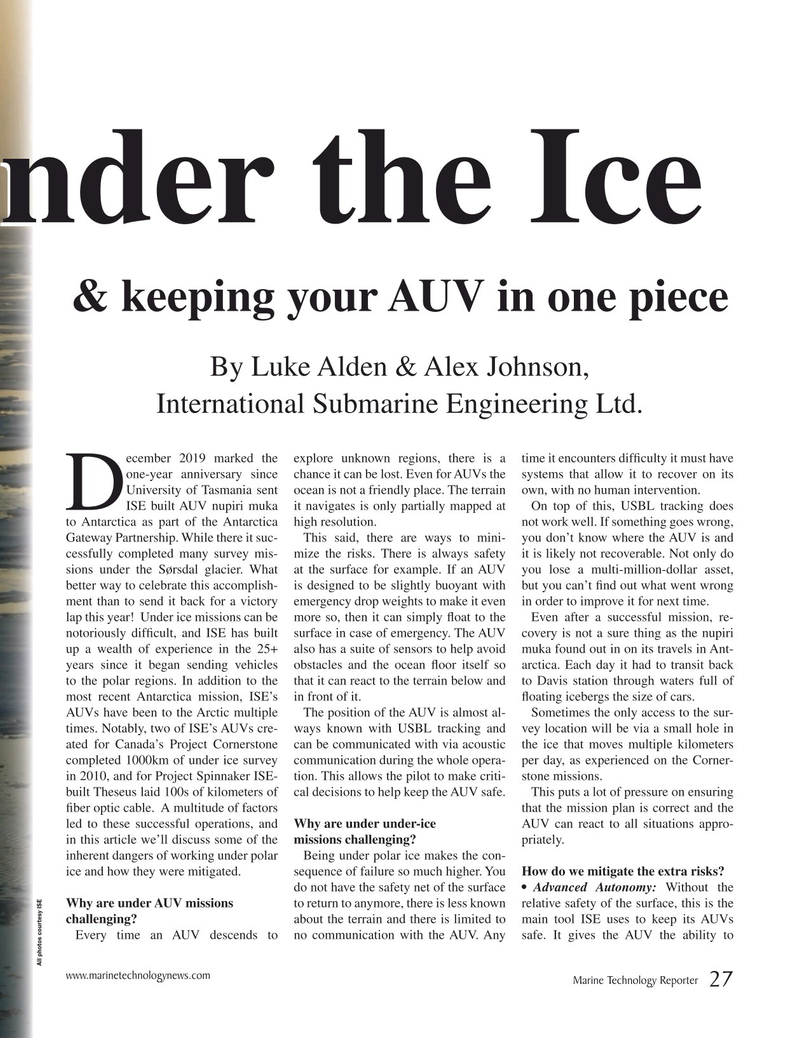
Page 27: of Marine Technology Magazine (January 2020)
Read this page in Pdf, Flash or Html5 edition of January 2020 Marine Technology Magazine
Under the IceUnder the Ice & keeping your AUV in one piece
By Luke Alden & Alex Johnson,
International Submarine Engineering Ltd.
ecember 2019 marked the explore unknown regions, there is a time it encounters dif? culty it must have one-year anniversary since chance it can be lost. Even for AUVs the systems that allow it to recover on its
University of Tasmania sent ocean is not a friendly place. The terrain own, with no human intervention.
DISE built AUV nupiri muka it navigates is only partially mapped at On top of this, USBL tracking does to Antarctica as part of the Antarctica high resolution. not work well. If something goes wrong,
Gateway Partnership. While there it suc- This said, there are ways to mini- you don’t know where the AUV is and cessfully completed many survey mis- mize the risks. There is always safety it is likely not recoverable. Not only do sions under the Sørsdal glacier. What at the surface for example. If an AUV you lose a multi-million-dollar asset, better way to celebrate this accomplish- is designed to be slightly buoyant with but you can’t ? nd out what went wrong ment than to send it back for a victory emergency drop weights to make it even in order to improve it for next time.
lap this year! Under ice missions can be more so, then it can simply ? oat to the Even after a successful mission, re- notoriously dif? cult, and ISE has built surface in case of emergency. The AUV covery is not a sure thing as the nupiri up a wealth of experience in the 25+ also has a suite of sensors to help avoid muka found out in on its travels in Ant- years since it began sending vehicles obstacles and the ocean ? oor itself so arctica. Each day it had to transit back to the polar regions. In addition to the that it can react to the terrain below and to Davis station through waters full of most recent Antarctica mission, ISE’s in front of it. ? oating icebergs the size of cars.
AUVs have been to the Arctic multiple The position of the AUV is almost al- Sometimes the only access to the sur- times. Notably, two of ISE’s AUVs cre- ways known with USBL tracking and vey location will be via a small hole in ated for Canada’s Project Cornerstone can be communicated with via acoustic the ice that moves multiple kilometers completed 1000km of under ice survey communication during the whole opera- per day, as experienced on the Corner- in 2010, and for Project Spinnaker ISE- tion. This allows the pilot to make criti- stone missions.
built Theseus laid 100s of kilometers of cal decisions to help keep the AUV safe. This puts a lot of pressure on ensuring ? ber optic cable. A multitude of factors that the mission plan is correct and the led to these successful operations, and Why are under under-ice AUV can react to all situations appro- in this article we’ll discuss some of the missions challenging? priately.
inherent dangers of working under polar Being under polar ice makes the con- ice and how they were mitigated. sequence of failure so much higher. You How do we mitigate the extra risks? do not have the safety net of the surface • Advanced Autonomy: Without the
Why are under AUV missions to return to anymore, there is less known relative safety of the surface, this is the challenging? about the terrain and there is limited to main tool ISE uses to keep its AUVs
Every time an AUV descends to no communication with the AUV. Any safe. It gives the AUV the ability to
All photos courtesy ISE www.marinetechnologynews.com
Marine Technology Reporter 27
MTR #1 (18-33).indd 27 1/16/2020 11:27:18 AM

 26
26

 28
28
